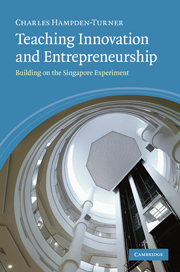Book contents
- Frontmatter
- Contents
- List of grids
- List of dilemmas
- Acknowledgements
- Introduction
- 1 Singapore’s challenge
- 2 The entrepreneurial ecosystem
- 3 How can innovative pedagogies be measured?
- 4 Co-defining innovative education
- 5 The Singapore results
- 6 Results of the Mandarin-speaking programme
- 7 Reconciling values
- 8 ‘It is only the Hawthorne Effect’
- 9 The programme that cannot stand still
- 10 Innovation and the future of the university
- 11 What are the implications of being able to teach innovation?
- 12 Is a new creative class arising?
- Notes
- Bibliography
- Appendices
- General index
- Index of dilemmas and reconciliations
3 - How can innovative pedagogies be measured?
Published online by Cambridge University Press: 05 July 2014
- Frontmatter
- Contents
- List of grids
- List of dilemmas
- Acknowledgements
- Introduction
- 1 Singapore’s challenge
- 2 The entrepreneurial ecosystem
- 3 How can innovative pedagogies be measured?
- 4 Co-defining innovative education
- 5 The Singapore results
- 6 Results of the Mandarin-speaking programme
- 7 Reconciling values
- 8 ‘It is only the Hawthorne Effect’
- 9 The programme that cannot stand still
- 10 Innovation and the future of the university
- 11 What are the implications of being able to teach innovation?
- 12 Is a new creative class arising?
- Notes
- Bibliography
- Appendices
- General index
- Index of dilemmas and reconciliations
Summary
There is a popular phrase, ‘it does not count!’. By this is meant that if we cannot somehow measure something then it pales into insignificance. Yet measuring innovation is a considerable challenge, made harder by the fact that being innovative or creative is very commonly faked. This fakery is quite rightly attacked and satirized. People can easily dress in Bohemian garb and behave in a bizarre fashion without being remotely innovative. While it is true that innovative persons have a large emotional stake in the outcome of their work, it is not true that getting emotional and flaunting an ‘artistic temperament’ is anything more than the affliction of amateurs.
As previously remarked innovative persons challenge the status quo, but the belief that giving a free rein to impulse will lead to some dawn of originality may be without basis. For example, student rebellions in the late sixties and early seventies did not go beyond protest and left few if any changes of substance in their wake. They even failed to persuade American governments not to embark on war against native insurgencies. But perhaps the most glaring attempt to counterfeit creativity was made by hippies and the counter-culture. They took every cliché of supposed artistry to an absurd extreme. They staged ‘spontaneous’ happenings in search of serendipity. They flaunted aimlessness, self-display and irresistible impulse.
- Type
- Chapter
- Information
- Teaching Innovation and EntrepreneurshipBuilding on the Singapore Experiment, pp. 43 - 57Publisher: Cambridge University PressPrint publication year: 2009



